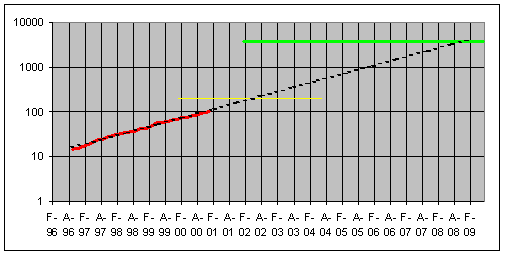
IPv6, How long can we wait?
-
This page was last updated in December 2000. It presents my prediction at that time, which may or may not turn out to be correct. Let's see how the network develops!
--Christian Huitema

The numbers, in the log plot, align pretty well. Lets compare the trend to the total number of IPv4 addresses that can be made available:
| 2 power 32 | 4,294,967,296 |
| Minus Class D,E (multicast, experiments) | -536,870,912 |
| Minus Net 0, 127 (null network, loopback network) | -33,554,432 |
| Minus private addresses (RFC 1918) | -17,891,328 |
| Available | 3,706,650,624 |
We plot that number as the green bar on the top of the graph. We see that it intersects the trend line in 2009. So, we get a first answer: by 2009, if we continue on the present path, we will have entirely run out of addresses. But the 2009 date supposes that we can actually entirely use all the available addresses. No network does that. During the IPv6 design process, I studied a few networks that had arguably run out of addresses, and I observed in RFC 1715 that there was a limit to the efficiency of address allocation, and that this limit was measured by the "H-Ratio," which compares the logarithm of the number of address in used to the logarithm of the number of addresses available in the numbering space. The H-Ratio analysis predicts that it will be very hard to use more than 200 million of the 3.7 billion available addresses. The 200 million limit is represented in the graph by the yellow line. It intercepts the current trendline in spring 2002!
There is always a risk of error with trendline analysis. Extrapolating a trend 9 years ahead, for example, is not realistic. We can be certain that things will change before 2009, that address allocation practices will become increasingly more restrictive as the available pools is depleted, and that the current exponential growth will be curbed by then. On the other hand, it is entirely realistic to extrapolate a 4 years trend for 1 and half year: the demand for more addresses is there, with always on broadband connections, new appliances, third generation wireless phones. So, we definitely have to get real: by 2002, IPv4 addresses will start to be very hard to get, and the pressure for deploying IPv6 will be intense.